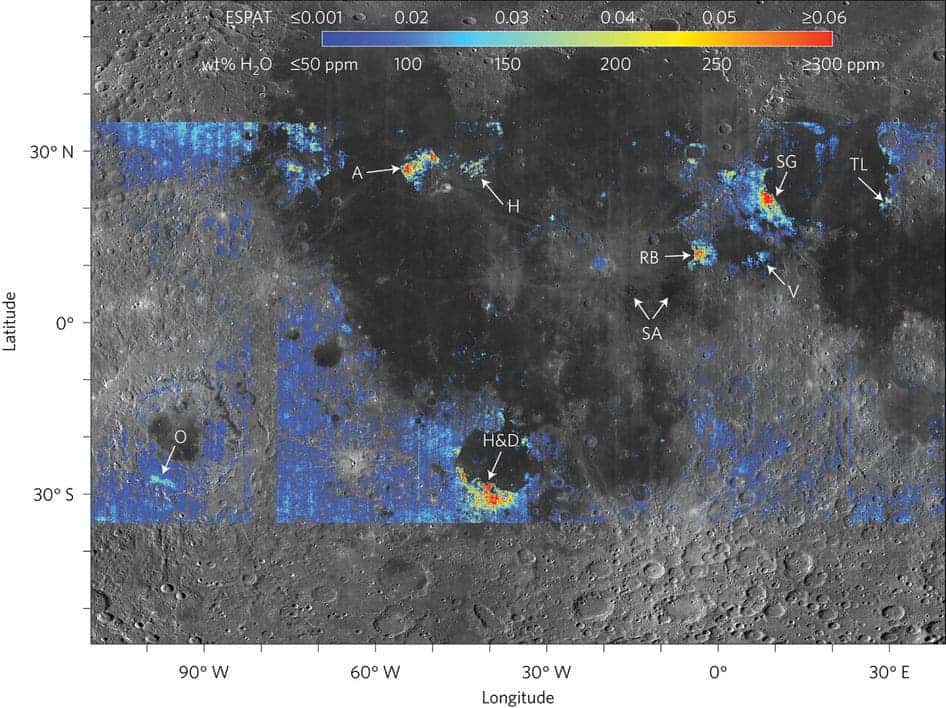
After studying data from a lunar orbiter mission but also results from lab tests on Apolo-era moon rocks, scientists have confirmed what others have been suggesting for the last decade: the moon’s interior is rich in water. The new study suggests that quantity of water encased in the moon’s mantle is actually far greater than previously believed. Questions remain, however, regarding what processes enabled the retention of all that water since the moon formed billions of years ago.
A wet moon
The water was detected in volcanic glass beads in OH/H2O (hydroxyl/water) form. These beads were formed eons ago during a time when the moon was dotted with explosive eruptions of magma, the kind we can still witness today on Earth in such places as Hawaii.
These glass beads are found embedded across the numerous volcanic deposits that litter the moon’s surface. During the Apollo 15 and 17 missions retrieved such beads ranging in size from only 20 to 45 microns and brought them back to Earth. Upon inspection, scientists found trace amounts of water but everyone just thought it must have been some kind of contamination which occurred during atmospheric reentry.
Since the Apollo missions, however, scientists have changed stance from a ‘dry moon theory’ as more and more evidence piled up that indicated the contrary. In 2008, researchers used a new technique to re-examine Apollo rocks and found that although there wasn’t that much water encased in the beads, it was estimated all the lunar beads hold a volume of water equivalent to the Caribbean Sea. Then in 2010, another group found water bound to phosphate minerals within volcanic lunar rocks. Steadily, other studies have pointed towards various locations on the moon high in concentration of hydrogen atoms, strongly suggesting the presence of water.

In this latest research published by Ralph Milliken from Brown University and colleagues, the scientists used data from an imaging spectrometer on India’s Chandrayaan-1 spacecraft that was in lunar orbit from 2008-2009. This instrument can detect minerals on the moon’s surface from high above and can also read temperature differences. The data revealed that unusually high amounts of water is trapped in volcanic deposits when compared to the surroundings.
“The water that we observe in the glass beads in these ancient fire fountain deposits came from the interior of the moon,” Milliken said. “This tells us that there is water in the moon’s mantle, and because the magma for these eruptions comes from very deep (several hundreds of kilometers down), there must be water in the deep interior of the moon.”
All of this water is, of course, not liquid but rather embedded in the rocky material akin to the water trapped within Earth’s mantle. This, however, brings up a vital question: how did all that water end up on the moon in the first place? The current leading theory is that the moon formed following proto-Earth’s impact with another planetary-sized body. The impact completely vaporized both bodies and from all the debris today’s Earth and its moon formed.
Some believe the energy involved was so great that all of the water must have vaporized and escaped into space. This traditional view is becoming more and more difficult to defend in light of multiple lines of evidence that show for a fact that water is present in the lunar deep interior. So, either some water survived the impact or it was later delivered by meteor impacts.
“By looking at the orbital data, we can examine the large pyroclastic deposits on the moon that were never sampled by the Apollo or Luna missions,” Milliken said in a press release. “The fact that nearly all of them exhibit signatures of water suggests that the Apollo samples are not anomalous, so it may be that the bulk interior of the moon is wet.”
Milliken and colleagues now plan to map the pyroclastic deposits in greater detail so that they can better understand how water concentrations vary among different deposits on the lunar surface.
Was this helpful?



